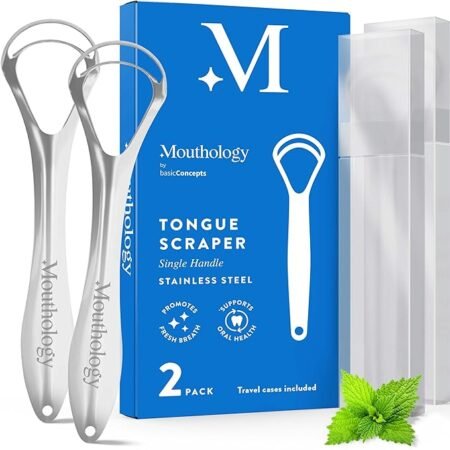
buy product
Introduction to Tongue Scrapers
Tongue scrapers, also known as tongue cleaners, are oral hygiene tools designed to remove bacteria, food debris, and dead cells from the surface of the tongue. These instruments, though seemingly modern, have a long history rooted in various cultures around the world. Historically, traditional tongue scraping can be traced back to ancient Indian Ayurvedic practices where it was believed to not only enhance oral cleanliness but also improve overall health and digestion. Similar practices were observed in ancient cultures of Rome and China.
In contemporary times, tongue scrapers have gained renewed attention as research has validated the benefits of tongue cleaning. By reducing the bacterial load on the tongue, these tools help combat bad breath, prevent oral infections, and promote overall oral hygiene. This resurgence is partly due to growing awareness about how oral health is intrinsically linked to general wellness.
There are various types of tongue scrapers available today, making it easy for individuals to find one that best suits their preferences and needs. Plastic tongue scrapers are lightweight and affordable, often recommended for those new to this practice. Metal tongue scrapers, usually made from stainless steel or copper, are durable and often preferred for their longevity and ease of sterilization. Additionally, some tongue scrapers come with bristles, combining scraping and brushing actions for a more thorough cleaning experience.
The cultural significance and continuing relevance of tongue scraping underscore its enduring value. Modern dental experts advocate for its inclusion in daily oral hygiene routines, echoing time-honored wisdom with scientific backing. Whether one opts for plastic, metal, or bristled varieties, incorporating a tongue scraper into their daily regimen can lead to markedly improved oral health and enhanced quality of life.
Health Benefits of Using a Tongue Scraper
Regular use of a tongue scraper can yield numerous health benefits, significantly enhancing oral hygiene and contributing to overall well-being. One of the most notable advantages is the reduction of bad breath, or halitosis. Bad breath is often caused by the accumulation of bacteria and food particles on the tongue, which emit foul odors. By removing these deposits, a tongue scraper can drastically improve breath quality and promote a fresher oral environment.
Another key benefit of tongue scraping is the improvement of taste sensation. Over time, a coating of debris and dead cells can form on the tongue, dulling taste perception. Regular scraping helps to clear this coating, allowing taste buds to function more effectively and enhancing the enjoyment of food flavors.
The removal of harmful bacteria and toxins from the tongue’s surface is another critical health advantage of using a tongue scraper. The tongue is a breeding ground for bacteria, which can contribute to oral and general health issues if not properly managed. By systematically removing these harmful substances, tongue scraping can reduce the risk of infections and promote a healthier oral microbiome.
Additionally, the practice of tongue scraping can contribute to overall oral hygiene. A clean tongue complements brushing and flossing, leading to a more comprehensive dental care routine. This holistic approach can help prevent plaque buildup, cavities, and gum disease, ultimately resulting in healthier teeth and gums.
Beyond oral health, tongue scraping has the potential to impact systemic health positively. There is evidence to suggest that a clean tongue may support better digestive and immune system function. By reducing the burden of harmful bacteria in the mouth, tongue scraping can help prevent these pathogens from entering the digestive system and bloodstream, thereby aiding in the maintenance of overall health.
How to Use a Tongue Scraper Correctly
Using a tongue scraper effectively requires adherence to specific steps and techniques to ensure comprehensive oral hygiene without causing any injury. To begin with, it is essential to invest in a high-quality tongue scraper that suits your preferences, whether it’s a stainless steel, plastic, or copper scraper.
The best time to incorporate tongue scraping into your oral hygiene routine is in the morning, right after brushing your teeth and before rinsing your mouth. This ensures that you remove any overnight accumulation of bacteria and debris on your tongue. However, if you wish, you can also scrape your tongue before going to bed for added cleanliness.
Here is the step-by-step guide to using a tongue scraper correctly:
1. Stick out your tongue as far as comfortably possible.
2. Place the tongue scraper at the back of your tongue, ensuring you do not go too far to avoid gagging.
3. Gently pull the scraper forward towards the tip of your tongue, applying light but steady pressure. Avoid pressing too hard to prevent injury to your taste buds and the delicate surface of your tongue.
4. Rinse the tongue scraper under running water after each scrape to remove any debris.
5. Repeat the process 3-4 times or until you feel your tongue is clean.
6. Complete the routine by rinsing your mouth with water or mouthwash to get rid of any loosened particles.
Common mistakes include scraping too harshly, which can cause irritation or damage, and neglecting to clean the scraper between strokes. Additionally, it’s crucial not to overdo the process; scraping your tongue once or twice a day is adequate in maintaining optimal oral hygiene.
By integrating tongue scraping into your daily routine correctly, you can significantly enhance your oral cleanliness and maintain a fresher breath, contributing to overall better health.
Choosing the Right Tongue Scraper for You
When selecting a tongue scraper, it’s essential to consider personal needs and preferences to ensure effective and comfortable oral hygiene. One of the first factors to evaluate is the material of the tongue scraper. Common materials include stainless steel, plastic, and copper, each offering unique benefits. Stainless steel tongue scrapers are durable, easy to clean, and resistant to bacteria buildup. Plastic tongue scrapers are often more flexible, lightweight, and may come in a variety of colors. Copper tongue scrapers possess natural antibacterial properties and are also sturdy and easy to clean.
Design is another crucial aspect to consider. Tongue scrapers come in various shapes, such as U-shape, straight, and V-shape. A U-shape scraper provides a comprehensive cleaning experience by covering a larger surface area of the tongue. Straight scrapers, being simple and straightforward, are easy to use for individuals new to tongue scraping. V-shape scrapers are noted for their precision, targeting specific areas with more control. Each design aims to improve the cleaning efficiency while catering to different user preferences.
Additional features can also enhance the functionality and convenience of a tongue scraper. Grip handles, for instance, offer better control and reduce the risk of slipping during use. Travel cases protect the scraper when on the go, ensuring it remains hygienic and ready for use. When it comes to maintenance and hygiene, adhering to best practices is vital. Regularly rinsing the tongue scraper with warm water after each use and occasionally using mild soap can prolong its lifespan and maintain its effectiveness. Additionally, it’s recommended to replace plastic tongue scrapers every few months, while metal ones can last longer with proper care.
By considering these factors—material, design, and additional features—you can select a tongue scraper that best suits your oral health needs, ensuring a fresher and cleaner mouth. The right choice not only improves your oral hygiene routine but also provides a comfortable and effective experience.
buy product
Discover more from detoatepentrutotisimaimult
Subscribe to get the latest posts sent to your email.
